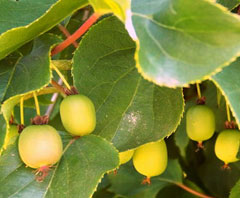 |
|
http://www.easytogrowbulbs.com/ |
 |
|
Translate this page:
Summary
Actinidia includes deciduous shrubs and vigorous, strong-growing vines native to temperate eastern Asia. All members of this genus produce edible fruits. The flowers are sweetly scented. Common Kiwifruit (A. deliciosa) and Hardy Kiwi (A. arguta) are suited to Mediterranean climates; they do less well in arid or semi-arid regions. Common or Fuzzy Kiwifruit is the best-known species growing to 9m (30ft). The fruit, rich in vitamin C, is very juicy and delicious. For a good crop of fruit, prune the plants to keep them small – if left unpruned, they will romp away and grow to the top of trees. Plants are usually either male or female, so you need to grow at least one male plant for every 4 – 5 females to get fruit. Some cultivars do not need a male for fertilisation, though they have inferior fruits. When grown from seed, most of the seedlings are male, so it is best to buy named varieties. Low-chill varieties are available.
Physical Characteristics

 Actinidia arguta cordifolia is a deciduous Climber growing to 7 m (23ft) at a fast rate.
Actinidia arguta cordifolia is a deciduous Climber growing to 7 m (23ft) at a fast rate.
It is frost tender. It is in flower from April to May, and the seeds ripen from October to December. The species is dioecious (individual flowers are either male or female, but only one sex is to be found on any one plant so both male and female plants must be grown if seed is required). and is pollinated by Bees, insects. The plant is not self-fertile.
It is noted for attracting wildlife.
Suitable for: light (sandy), medium (loamy) and heavy (clay) soils. Suitable pH: mildly acid, neutral and basic (mildly alkaline) soils. It can grow in semi-shade (light woodland) or no shade. It prefers moist soil.
UK Hardiness Map
US Hardiness Map
Synonyms
A. cordifolia. Miq. A. platyphylla. A.Gray. A. rufa cordifolia. Dunn. A. rufa dulcisisma. Koidz.
Plant Habitats
Woodland Garden Sunny Edge; Dappled Shade; South Wall. By. West Wall. By.
Edible Uses
Edible Parts: Fruit
Edible Uses:
Fruit - raw or cooked[177]. Smooth skinned with a sweet flesh[183]. About the size of a grape[183]. The globose to oblong fruit is greenish-yellow or purple-red when mature and 2 - 3 cm long[266]. It contains a number of small seeds, but these are easily eaten with the fruit[K].
References More on Edible Uses
Medicinal Uses
Plants For A Future can not take any responsibility for any adverse effects from the use of plants. Always seek advice from a professional before using a plant medicinally.
None known
References More on Medicinal Uses
The Bookshop: Edible Plant Books
Our Latest books on Perennial Plants For Food Forests and Permaculture Gardens in paperback or digital formats.

Edible Tropical Plants
Food Forest Plants for Hotter Conditions: 250+ Plants For Tropical Food Forests & Permaculture Gardens.
More

Edible Temperate Plants
Plants for Your Food Forest: 500 Plants for Temperate Food Forests & Permaculture Gardens.
More

More Books
PFAF have eight books available in paperback and digital formats. Browse the shop for more information.
Shop Now
Other Uses
Most Actinidia species are not self-fertile. Male and female plants are required for fruit production. Kiwifruit is typically harvested in late autumn to early winter, depending on the variety and climate. Kiwifruit flowers in spring. Kiwifruit vines are fast-growing and can reach maturity in 3-4 years, producing fruit within that timeframe. They require support structures for optimal growth.
Special Uses
Scented Plants
References More on Other Uses
Cultivation details
Prefers a sound loamy neutral soil[1, 200]. Succeeds in semi-shade but full sun is best for fruit production[200]. Prefers a sheltered position[200]. This is a very vigorous plant that can climb to the tops of tall trees[182]. Very hardy, tolerating temperatures down to -30°c or more, but young spring growth is susceptible to frost damage[160]. Fruits are formed on second year wood and also on fruit spurs on older wood[126], any pruning is best carried out in the winter[219]. The small flowers are sweetly scented[245]. This is a climbing plant, supporting itself by twining around branches etc[200]. Sometimes cultivated for its edible fruit, there are some named varieties[183]. Dioecious. Male and female plants must be grown if seed is required. Plants in this genus are notably resistant to honey fungus[200]. Most Actinidia species are not self-fertile. Male and female plants are required for fruit production. Kiwifruit is typically harvested in late autumn to early winter, depending on the variety and climate. Kiwifruit flowers in spring. Kiwifruit vines are fast-growing and can reach maturity in 3-4 years, producing fruit within that timeframe. They require support structures for optimal growth.
References Carbon Farming Information and Carbon Sequestration Information
Temperature Converter
Type a value in the Celsius field to convert the value to Fahrenheit:
Fahrenheit:
The PFAF Bookshop
Plants For A Future have a number of books available in paperback and digital form. Book titles include Edible Plants, Edible Perennials, Edible Trees,Edible Shrubs, Woodland Gardening, and Temperate Food Forest Plants. Our new book is Food Forest Plants For Hotter Conditions (Tropical and Sub-Tropical).
Shop Now
Plant Propagation
Seed - sow spring in a greenhouse[133]. It is probably best if the seed is given 3 months stratification[113], either sow it in a cold frame as soon as it is ripe in November or as soon as it is received. Fresh seed germinates in 2 - 3 months at 10°c, stored seed can take longer[133]. When they are large enough to handle, prick the seedlings out into individual pots and grow them on in light shade in the greenhouse for at least their first winter. When the plants are 30cm or more tall, plant them out into their permanent positions in late spring or early summer, after the last expected frosts[K]. Most seedlings are male[126]. The seedlings are subject to damping off, they must be kept well ventilated[113]. Cuttings of softwood as soon as ready in spring in a frame[K]. Cuttings of half-ripe wood, July/August in a frame. Very high percentage[113]. Cuttings of ripe wood, October/November in a frame.
Other Names
If available other names are mentioned here
Native Range
Coming Soon
Weed Potential
Right plant wrong place. We are currently updating this section.
Please note that a plant may be invasive in one area but may not in your area so it's worth checking.
Conservation Status
IUCN Red List of Threatened Plants Status :

Growth: S = slow M = medium F = fast. Soil: L = light (sandy) M = medium H = heavy (clay). pH: A = acid N = neutral B = basic (alkaline). Shade: F = full shade S = semi-shade N = no shade. Moisture: D = dry M = Moist We = wet Wa = water.
Now available:
Food Forest Plants for Mediterranean Conditions
350+ Perennial Plants For Mediterranean and Drier Food Forests and Permaculture Gardens.
[Paperback and eBook]
This is the third in Plants For A Future's series of plant guides for food forests tailored to
specific climate zones. Following volumes on temperate and tropical ecosystems, this book focuses
on species suited to Mediterranean conditions—regions with hot, dry summers and cool, wet winters,
often facing the added challenge of climate change.
Read More
Expert comment
Author
(Miq.)Bean.
Botanical References
198266
Links / References
For a list of references used on this page please go here
Readers comment
| Add a comment |
|
If you have important information about this plant that may help other users please add a comment or link below. Only comments or links that are felt to be directly relevant to a plant will be included. If you think a comment/link or information contained on this page is inaccurate or misleading we would welcome your feedback at [email protected]. If you have questions about a plant please use the Forum on this website as we do not have the resources to answer questions ourselves.
* Please note: the comments by website users are not necessarily those held by PFAF and may give misleading or inaccurate information.
To leave a comment please Register or login here All comments need to be approved so will not appear immediately.
|
Subject : Actinidia arguta cordifolia
|
|
|
|